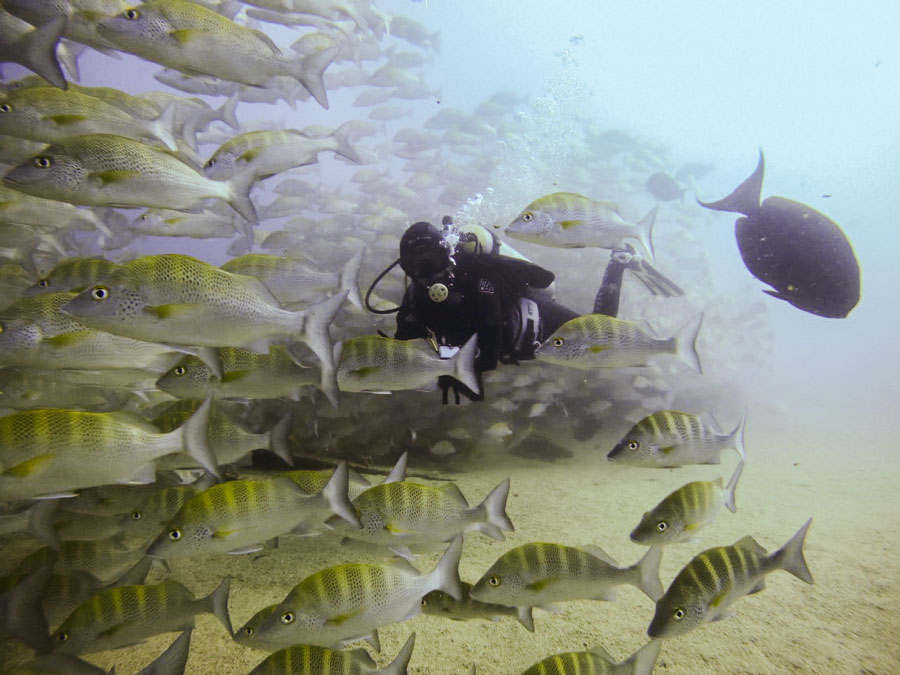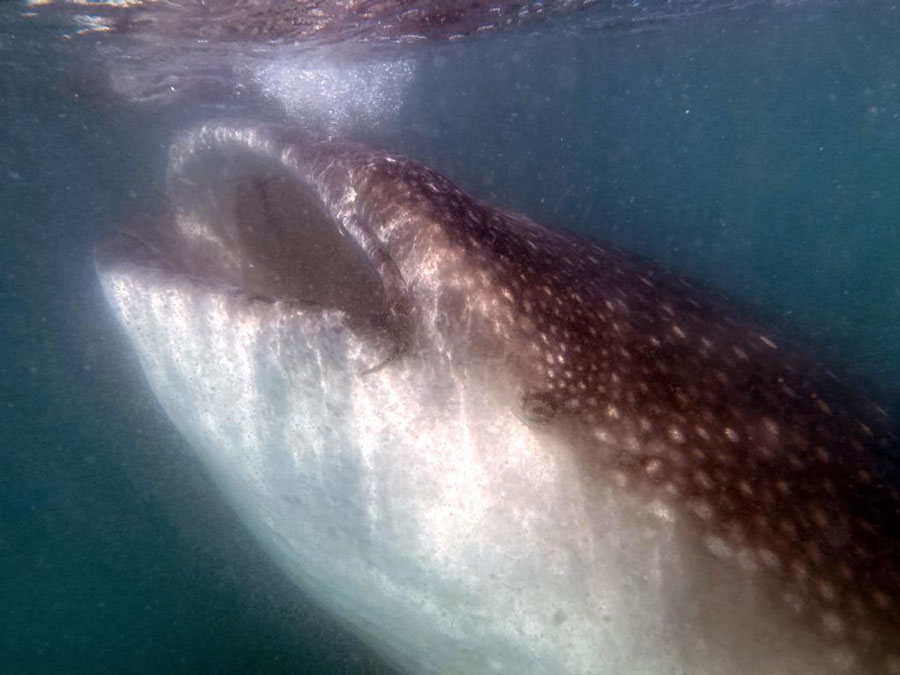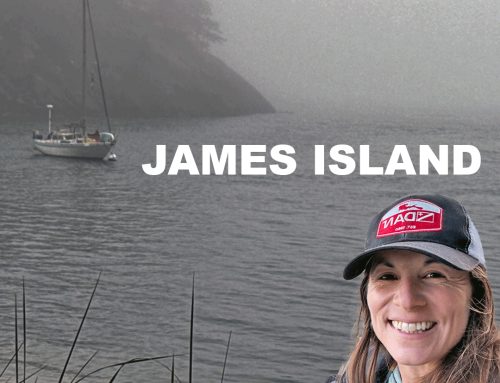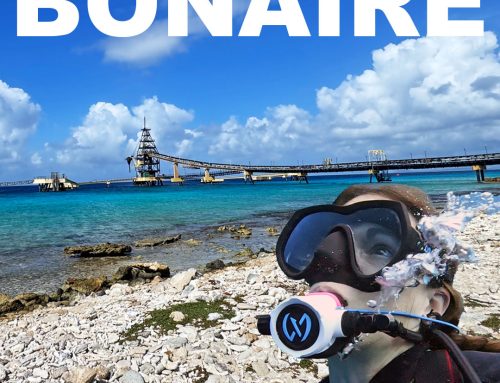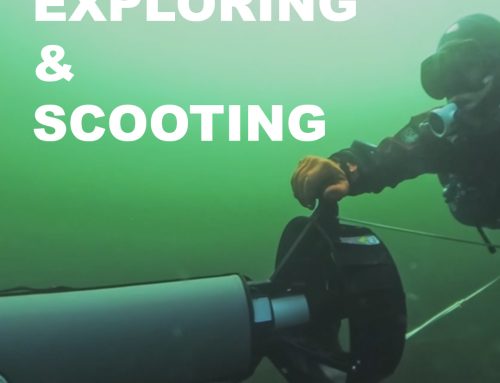I have been trying to get to Socorro for years. About a year ago, I attempted to sell a trip to the famous islands in Mexico, but I failed. When another opportunity came up, I was a little hesitant, but the mission of the new trip inspired me to take a leap of faith.
If you’ve been following me for a while, you’ve heard me speak about the nonprofit organization, Fins Attached. They are a marine research NGO based in, you guessed it, Colorado. But seriously, they run trips to help fund and advance studies focused primarily on sharks and rays. When I met the founder, we decided to work together on a shark research trip. Unfortunately, due to permit restrictions from the Mexican government, we had to switch the trip focus to manta rays, which I’ll cover in detail later.
Heading out to Revillagigedo
Boarding the boat for a week of adventures with new and old friends was exciting. Of course some of my Seattle crew joined the fun, but we had people who flew in from Germany, France, Nicaragua, Canada, and all over the US. The group was eclectic and immediately bonded over the common goal of supporting ocean conservation.
By nightfall we were off on a long, super rocky boat ride to Socorro. By the way, Socorro is not the most accurate name for the area, but the most recognizable colloquially among divers. The name for this region of Mexico is pretty challenging for English speakers and I actually only grew confident in saying it after a week of hearing it every day… and I consider myself fluent in Spanish… So let’s work on it together. REH-VEE-YAH-HEE-HAY-DOH, el archipiélago de Revillagigedo. Ok, that was maybe a lot. Let’s go with the Revillagigedo Islands, or the short form nickname is Revilla.
What can you see in the Revillagigedo Islands?
To visit Revilla, you need the Advanced Open Water certification and 50 logged dives. Your buoyancy needs to be on point and it’s best to have some comfort with currents.
Nestled nearly 250 miles off Mexico’s Pacific coast, Revilla is made up of four islands: Socorro, San Benedicto, Roca Partida, and Clarión. Volcanic activity created steep underwater walls and dramatic topography in the middle of the ocean. This isolation and unique structure make them a hotspot for marine biodiversity. In 2017, the Mexican government established the Revillagigedo National Park, banning fishing and all extractive industries to create the largest fully protected marine reserve in North America. It was a massive step for ocean conservation, preserving over 60,000 square miles of critical habitat. This move was possible thanks to research and conservation efforts in the area, including a pivotal Fins Attached expedition which took place in January 2017.
Partnering with Mission Blue, Fins Attached helped lead a Hope Spot Expedition to highlight the ecological importance of the region and the urgent need for enhanced protection. Their team deployed underwater acoustic monitoring devices to track the movement and behavior of sharks in the area, providing vital data on how these animals use the islands as part of a larger migratory corridor connecting Revillagigedo to other marine reserves like the Galapagos and Cocos Island. This information underscored the region’s importance for shark conservation and supported the case for permanent protection.
Here, pelagic life thrives. Over 7 species of different sharks are regularly seen, oceanic manta rays with wingspans of 15 feet or more, and even whale sharks glide through these nutrient-rich waters. Humpback whales migrate through from January to March (we even saw them in early May), and dolphins are often cruising around dive sites, luring unsuspecting divers into deco.
The seamounts and submerged ridges surrounding the islands create natural cleaning stations where all the different players in this ecosystem congregate.
Shark species in the archipelago
The Revillagigedo Islands are a true sanctuary for shark enthusiasts, offering encounters with an impressive variety of species. Most famously, divers can witness large shivers of hammerhead sharks. Not to be outdone, Galápagos, silvertips, dusky, oceanic blacktips, silky, and whitetip reef sharks regularly make appearances to wow divers throughout the year. Even tiger sharks have been known to make appearances as well. It is one of the most reliable places on Earth to observe multiple shark species on a single dive trip.

Losing scuba diving gear to the Pacific Ocean
An important thing to note about diving out here is the bathymetry (the shape of the underwater terrain). Many of these dive sites are deep wall dives which means you should definitely have clips, bolt snaps, or bungees for all of your accessories. Several people dropped cameras and torches throughout the week, but we were able to retrieve all of them (one of our divemasters even had to go on a special recovery dive for a GoPro).
Manta ray body mucous research
Alright, let’s talk about manta ray research. Our two scientists, Fernanda and Maria, collaborated on a brand new research topic regarding the properties of manta ray body mucus. As divers, we’ve all been taught that mucus is a protective barrier, but we haven’t known specifics about why it helps. This study will hopefully shed light on the topic. Fernanda and Maria used a camera and laser setup to collect identification and size data. Mucus samples were collected with toothbrushes in sample vials. They collected dorsal and ventral samples, the back and belly respectively, as well as a water sample in order to compare organisms in the water with those found in the mucus.
It was impressive to watch them complete this work. Anyone who has been in the water with oceanic manta rays knows those giants are fast. Maria chose freediving fins for this trip to give her more power to keep up with them, but she still had to be strategic and patient about getting all the necessary samples.
After the dives, the samples were preserved in alcohol and put in cold storage until they can be processed back on the mainland. We are all looking forward to hearing about the findings of this study so we can share more information about the importance of not touching manta rays.
We didn’t get much dolphin activity on this trip, so when I saw them, I made a lot of noises to keep them engaged a little longer. They kept circling back to see what the crazy creature singing at them was all about.
Diving at Roca Partida
We were not prepared for what awaited us. This is one of the most iconic dive sites of all the Revillagigedo Islands.
Diving Roca Partida is like dropping into the center of a blue wilderness cathedral. This unique rock juts dramatically out of the Pacific and plunges deep below the surface. With no shelter from the elements, dive days here have to be planned according to the weather forecast, and it’s well worth the effort to explore. The exposed location means currents can be strong and unpredictable, but with currents come loads of pelagic action. Divers often descend into massive schools of jacks and tuna, swim eye to eye with manta rays, and hover near balconies where whitetip reef sharks pile up to rest.
Unlike most shark species that need to keep swimming to breathe, whitetip reef sharks have the unique ability to rest motionless on the seafloor by actively pumping water over their gills. This allows them to lounge on the reef during the day, often tucked into caves or resting under ledges. Even more endearing is their habit of gathering in groups, or what I like to call cuddle puddles.
On the very last dive here at Roca Partida, we were blessed with the most unforgettable sighting. What started out as a faint irregularity of shadows and white dots, out of the deep came a whale shark. And it was huge. After sending our footage to a whale shark marine biologist in La Paz, we discovered that this particular individual was not in the database. Our marine biologist Maria was the first to spot it, so she gave it the name Sunny.
Giving manta rays a spa treatment
Diving with oceanic manta rays is an intimate experience, particularly in Revilla. They often seem to seek out human interaction by gliding up to divers with what seems like curiosity in their eye contact. They also lingered above divers to feel the sensation of exhaled bubbles on their bellies, returning again and again as if enjoying a spa treatment. Each encounter felt personal and profoundly moving. There even came a point in the trip where manta ray sightings were so regular, that they became part of our dive team.
Choosing the right exposure suit for Socorro diving
Water temperatures in the Revillagigedo Islands typically range from 72°F to 80°F (22°C to 27°C), depending on the season. Cooler temperatures are more common from December to April, especially at depth. Many divers are comfortable in a 5mm wetsuit with a hood, though some prefer a 7mm suit for longer dives or to stay warm for repetitive diving days.
I rented a 5mm suit and toward the end of the trip, I really regretted it. I didn’t have space in my luggage for my 7mm, but if I were to go back, I would install a p-valve on my drysuit and keep it on all day. The wind was killer out there and I probably would have died without my Surffur waterparka.
Cabo Pearce
Although the pelagics steal the show in Revilla, there is abundant macro and fish life out here. We saw tons of nudis and all of us grew a deep appreciation for seeing Clarion angelfish on the dives. Arturo, one of the other marine scientists, taught us that Clarions are one of the main cleaner fish for oceanic manta rays, and for many years they were disappearing from the ecosystem. This wasn’t a climate change or habitat destruction problem as we’ve seen in many other parts of the world. This issue was linked directly to aquariums. Clarion angelfish grew very popular among saltwater aquarium enthusiasts. That meant fishing companies could collect a high price by capturing them from cleaning stations and transporting them for sale.
These fishing teams would avoid limits and regulations by claiming the Clarions were Garibaldi. Anyone who’s ever seen a Garibaldi would immediately know the truth, but that’s the thing about the fishing world. Lying and corruption go hand in hand with overfishing, bycatch, and the destruction of habitats.
Now that stricter conservation rules are in effect, the Clarion angelfish population has rebounded spectacularly and we witnessed them in their natural state, cruising around cleaning stations.
It’s truly incredible how worn out your body can feel during a liveaboard trip. My body was aching all over the place because I’m really not used to doing this much diving anymore. It’s also a not so subtle reminder that although I’m not old, this 37 year old body doesn’t recover quite as fast as my full time instructor body did in my 20’s. Hell, even my early 30’s… But that didn’t stop me from hopping in the water for every single dive on this trip.
The most unexpected sighting of the trip
On our last day of diving, we had a second chance to enjoy the shark capital of Revilla, el Cañon and two of us really lucked out here. My dive buddy Yann and I got distracted by an octopus who was out and about on the reef. We filmed it for a while and then moved on to catch up with the rest of our dive team. As we were swimming, I turned around to check in and noticed a dark shadow approaching Yann from behind. I signaled for him to turn around and the shark came into view. It was huge… and as it turned, it revealed the familiar stripes of a tiger shark. Both of us were stunned. The encounter only lasted seconds before it flitted out of sight again. It was too far for me to capture any footage, but it was a moment that I will never forget.
Life is too short to put off living
There were countless beautiful moments on this liveaboard trip and it is easy to get lost in the schedule and excitement of the sleep, eat, dive lifestyle. However, that doesn’t mean real-life stuff pauses back home. Mid-way through the trip I found out that my uncle was in the hospital and put on life support. The next day he was gone. That night, I had a moment to myself at the stern of the boat watching sharks dance through the lights. My heart hurt, but that kind of grief wasn’t something I wanted to share with people, so the sharks turned out to be perfect companions. And as I began to process the grief, I found comfort in the smallness I felt next to the mantas.
Death is always a powerful reminder of the beauty of life as we know it on this floating rock in space. It’s easy to take life for granted, to go to sleep at night assuming morning will come, but that’s not going to be the case forever. It might be morbid, but death reminds me to take chances, to chase my dreams, and to appreciate even the tiniest moments of awe.
My own mortality is also why I believe it’s important to go on dive trips and travel as much as possible. One day, I may not be fit or able to dive anymore and I don’t want any regrets when that time comes. It’s easy to get caught up in life and find reasons why I can’t afford to travel or don’t have time for it, but it’s important to strike a balance of showing up for the adulting part of life while allowing the free, wild child to get out and play.
The boat ride to Cabo San Lucas was pretty rough. What normally is a 24-30 hour ride took us about 34 to get back and everyone was grateful to see land. It was all worth it.
Join me on upcoming Azul Unlimited dive expeditions
See what trips are coming up. I always give my community first dibs on spots, so you can sign up for Patreon (and get trip discounts) or my email list to be the first to know about new expeditions in the future.
